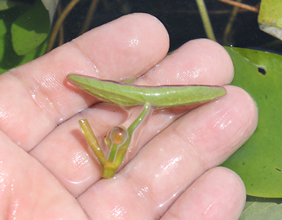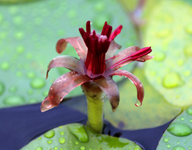
「じゅんさい」は、沼や池に自生するスイレン科の多年生水草です(学名:Brasenia schreberi J.F.Gmel)。茎は水底の沼の中の根茎から長く伸び、夏季にハスの葉のように水面いっぱいに浮葉を広げます。水面下の、寒天状のぬるぬるとした透明な粘質物の付いた幼葉(若葉、若芽、新芽等と呼ばれる)や葉柄を摘んで、食します。
とても淡泊な味わいですが、水中に芽吹く「エメラルド」とも讃えられる、涼しげな風情とツルッとした食感・喉ごしが、夏の到来を感じさせてくれます。
古くから食用とされており、『古事記』や『万葉集』などに奴那波・沼縄(ヌナハ、あるいはヌナワ)という記載がみられます。江戸時代中期の『農業全書』でも、山野菜の一つに挙げられ、栽培方法についても触れられています。
じゅんさいの収穫は5月下旬から8月上旬頃までと、僅かな期間のみです。
Junsai Picking in Mitane
Junsai, often called “watershield” in English, is a perennial aquatic plant with edible buds that are considered a delicacy in Japanese cuisine. Its small, round leaves float on the surface of shallow ponds, and the prized buds develop just below the surface. Because edible junsai can only be grown in places with excellent water quality, areas fed by runoff from Shirakami Sanchi’s pristine wilderness are ideal for its cultivation. Akita Prefecture is known for producing an overwhelming 90 percent of Japan’s junsai, and most of it comes from the town of Mitane.
To pick junsai, harvesters sit in a flat-bottomed boat and steer with a pole braced against the bottom of the pond, which is only about 60 centimeters deep. Reaching into the water with one hand, they feel for the buds—a rolled, immature leaf—and pinch them off the main stem. This can be difficult due to the buds’ slippery defensive coating. The buds are collected in buckets and rinsed thoroughly prior to consumption.
Junsai has several recognized health benefits deriving from its high fiber and polyphenol content. In Japanese cuisine, it is commonly added to soups and hot pots, or eaten with a dressing of soy sauce and wasabi. Junsai-picking season runs from mid-May through August. Guests who go to one of the many farms in Mitane are guided through the picking process by experienced harvesters and can take home all that they pick.

「じゅんさい」の花は、水面に近い葉脈に長い柄をのばし、頂に1個つけます。直径1〜2センチの暗紅紫色の可憐な小花です。日中に開き、夕刻に水没し結実します。小さな、はかない花であることから、愛おしさが募ります。
清らかで豊かな水でしか育たない「じゅんさい」。実にその90%以上は水でできています。じゅんさいの産地として古くから知られる秋田県三種町森岳地区には、およそ200を数える沼が点在します。沼には、世界遺産白神山系「素波里」と出羽山系「房住山」から流れ込む水や、湧き出る地下水が豊富な栄養素を運び、絶滅危惧種に指定されている「メダカ」や「タヌキモ」、「ホッスモ」が生息しています。またその他にもクロイトトンボやトノサマガエル、マルタニシなど多くの生き物たちが沼で生息し、自然豊かな生態系を覗くことができます。
かつてじゅんさいは日本全国で観察され、高級食材として珍重されてきましたが、今や4都県で絶滅、22県で絶滅または準絶滅危惧種となっています。(「日本のレッドデータ検索システム」2021)
「じゅんさい」は多糖類に富んでいるゲル状質に覆われており、葉にはポリフェノールが30%以上(※1)の割合で含まれています。
さらにカロリーも低いことから、ヘルシー食品として認知も進みつつあります。
※1 出典:オリザ油化、Harvestect、秋田県総合食品研究センター共同研究製品開発発表資料より






